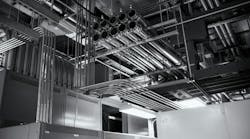As the deadline for filing tax returns fast approaches, every electrical contractor should be aware of the many changes to our tax laws — changes that will affect the tax bill for 2008 and many years to come. Naturally, not all of the recent tax law changes applied to the electrical construction and maintenance business. For example, last summer's passage of the Housing and Economic Recovery Act of 2008 was notable for the absence of significant business-related tax incentives. The bill's First-Time Homebuyer Tax Credit, the Reduced Home Sale Exclusion, and other consumer-oriented provisions virtually hid the acceleration of large-corporation estimated tax payments.
Stimulating the economy
Earlier in 2008, the Economic Stimulus Act of 2008 was signed into law complete with rebates and business incentives. Most noticeable for the recovery rebates, reaching as high as $600 for individuals and $1,200 for married couples, the new law also included $44.8 billion in business incentives.
For electrical contractors who acquire equipment, the new law almost doubled the Section 179 immediate write-off for newly acquired equipment to $250,000 — but only for 2008. Thus, up to $250,000 of the cost of equipment acquired (and placed in service in 2008) can be treated as a business expense and fully deducted on the tax returns for the 2008 tax year. Should newly acquired equipment costs total more than $800,000 for 2008, the $250,000 Section 179 write-off must be reduced (dollar-for-dollar) for the excess above the $800,000 ceiling.
Another provision in the stimulus package allowed electrical businesses to claim a 50% “bonus” depreciation allowance for newly acquired equipment. To qualify, the equipment must be eligible for depreciation and have a useful life longer than 20 years. Off-the-shelf computer software and improvements made to leased business properties also qualify for bonus depreciation. Best of all, the 50% bonus depreciation applies in both the 2008 and 2009 tax years.
In the fall, Congress passed and President Bush signed into law a historic financial markets rescue bill, the Emergency Economic Stabilization Act (EESA) of 2008. Although the new law's primary purpose was to solve the credit crunch in the financial markets, it also served as one of the largest tax bills in recent history. Included were almost 300 changes to tax laws, tax breaks expected to save taxpayers a whopping $150 billion. Designed specifically for small contractors, business owners, and professionals who are, according to lawmakers, the ones with large amounts of deposits at risk, the bailout bill raised the FDIC and National Credit Union Share Insurance Fund deposit insurance limits from $100,000 per account to $250,000. Remember, however, the increased levels are only temporary, expiring after 2009.
Leasehold improvements
As mentioned previously, earlier tax law changes shortened the cost recovery period for improvements made to leased business property from 39 to 15 years. The new law not only extends the faster write-offs for those so-called “leasehold improvements” until the end of 2009, but it also allows retail businesses and restaurants to benefit from similar shortened recovery periods.
Because electrical contracting firms lease property and improvements to qualify for the faster write-off, they will share in tax savings estimated to reach $8.7 billion over 10 years. The shorter 15-year write-off period, for more permanent types of improvements to leased or retail locations, is good only for the 2009 tax year, however. On the other hand, the retail property write-offs apply to owner-occupied businesses as well as leased establishments.
Tax benefits for energy savings
The tax law changes also extended a number of energy tax incentives, many of which apply to electrical contractors. Quite a few extensions go beyond the one- or two-year periods authorized by lawmakers for non-energy extenders.
Among the provisions extended were several energy-efficiency and energy property tax incentives. For example, an eight-year extension of investment credits for solar energy was extended, as were breaks for wind, geothermal, and other alternative sources. In addition to tax credits for using solar or alternative energy in the business (see Photo above), there is also a unique tax deduction available to anyone making a commercial building more energy efficient.
Tax deductions for energy-efficient buildings have been extended through Dec. 31, 2013 and are expected to generate tax savings in excess of $890 million over a 10-year period. Rather than a deduction for the cost of equipment or improvements to make a commercial building more energy efficient, the deductible is up to $1.80 per square foot of building floor area for buildings achieving a 50% energy savings target. A lesser flat-rate deduction is available for achieving smaller energy savings.
Under the tax rules, to qualify, energy savings must be accomplished through energy and power cost reductions for the building's heating, cooling, ventilation, hot water, and interior lighting systems.
The new markets tax credit and more
The New Markets Tax Credit is one of the few incentives in U.S. tax law to encourage taxpayers to invest in or make loans to small businesses in economically distressed areas. Created to increase investment in low-income communities, the total credit equals 39% of the investment over seven years.
Set to expire at the end of 2008, the New Markets Tax Credit was extended through December 2009, generating an expected tax savings of $1.3 billion over 10 years. Because financing is difficult to obtain for all businesses, this is yet another avenue that electrical contractors, among others, can tap into. If they qualify, the tax credit for investors means more money should be available to them.
Other tax provisions contained in last fall's EESA might be of limited benefit to an electrical contractor or business. They include:
-
The downside of tax savings
Enhanced charitable deductions for qualified computer contributions to schools.
-
Investments in recycling: Businesses can claim accelerated depreciation for purchases of equipment used to collect, distribute, or recycle a variety of commodities.
The downside of tax savings
Although these tax breaks passed with only minimal “revenue enhancers,” there are a few provisions designed to offset the loss to the U.S. Treasury. Approximately $44 billion in offsets will mean tax increases for some taxpayers. The Federal Unemployment Tax Act (FUTA) surtax is one such area.
FUTA imposes a 6.2% gross tax rate on the first $7,000 paid annually by employers. In 1976, Congress passed a temporary surtax of 0.2% of taxable wages to be added to the permanent FUTA tax rate. The temporary surtax subsequently has been extended through 2008. This bill extends the surtax for one year only — at an estimated cost to employers of $1.474 billion over 10 years.
An electrical contractor or professional might, for example, have acquired necessary equipment in 2008. The expenditure for that equipment would qualify as a Section 179 expensing deduction, small enough not to trigger the ceiling. However, with little in the way of profits, a depreciation write-off over a number of years (when profits will hopefully, be greater and the tax bracket more onerous) might be more advantageous.
Planning in the face of change
To add to the changes, there is a lot more tax legislation on tap. At the top of the list is the question of whether to extend many of the temporary provisions enacted in the Economic Growth and Tax Relief Reconciliation Act of 2001 (EGTRRA), such as the lower individual marginal income tax rates and relief of the marriage penalty. EGTRRA also repealed the federal estate tax but just for 2010. These temporary provisions will expire after 2010. Additionally, lower capital gains and dividend tax rates will sunset within the next few years.
Of more immediate interest may be the basic tax deductions, deductions that warrant attention prior to the electrical operation's — and the owner's — tax filing deadlines.
The home shop or office — If you or some of your staff members regularly work from home, you may be entitled to a tax deduction for expenses related to operating that home office. In fact, this deduction may be available to you as an individual even if you have an outside-the-home office and do the bulk of your work at home.
The home office or shop deduction is available to employees, business owners, and self-employed electrical contractors and offers many opportunities for tax deductions. Virtually all outside expenses are deductible, including rent, utilities, insurance, repairs, improvements, maintenance, and the like.
Business smarts — Uncle Sam wants you to get better at what you do, as well as enjoy the fruit of your labor — after taxes. For example, you can deduct expenditures to maintain or improve existing skills, so long as they are related to electrical design, construction, or maintenance. The cost of education that qualifies you for a new job or profession is not deductible, of course.
Business benefits — As business owners, electrical professionals have an advantage that most other businesses do not have with regard to health care costs — they can deduct many of their health insurance costs from their taxes.
When it comes to saving for retirement, electrical contractors and other small business owners are better off than their employees. This is because the government allows small businesses to set up retirement accounts specifically designed for small business owners. Obviously, these retirement accounts cannot ignore any employees the operation may have, but they can and do provide enormous tax benefits intended to maximize the amount of money that can be put away in tax-deferred accounts during working years.
Just for fun — There are also those enjoyable, entertaining tax deductions. Frequently, important business meetings, client contacts, and marketing efforts take place at restaurants, golf courses, or sporting events. Under U.S. tax rules, you can deduct amounts spent for entertainment and half of the amounts spent for food and beverage. Remember, however, because taxpayers continue to abuse this deduction, the IRS has strict rules limiting the types and amounts of entertainment costs that are tax deductible — and they enforce them, providing another good reason to seek professional tax advice.
Self evaluation
Another issue you should discuss with your tax professional is the still unresolved and highly complex question of who is an independent contractor and who is an employee? Many electrical professionals prefer the independent contractor label because of the flexibility it provides as well as the extra tax write-offs that go with it. Those who use “independent contractors” generally avoid the paperwork and payroll taxes associated with employees.
Although the IRS has published guidelines with 20 factors in an effort to help resolve the controversy that exists in this area, the IRS and many state tax authorities continue to question the independent contractor status of many workers. Deciding whether an electrical professional is an employee of his or her business is, fortunately, a far less controversial area. The courts have ruled on several occasions that a shareholder who provides substantial services to his or her incorporated business, even an S corporation — is an employee insofar as withholding is required.
In the area of fringe benefits, retirement plans, and the like, the majority of shareholder/owners, partners, and principals are considered employees of the business, entitled to reap all rewards offered by the business. Naturally, those benefit programs cannot discriminate in favor of the owner/shareholder or any highly compensated worker.
It should be obvious by now that professional advice is a virtual necessity for every electrical contractor as well as every business owner and manager. It's not too late to take full advantage of the new — and, in many cases, temporary — tax breaks that became a reality during 2008. Nor is it too late to develop a strategy that will help reduce the tax bill for the 2008 tax year — and for many years to come.
Battersby is a freelance writer with offices in the suburban Philadelphia community of Ardmore, Pa. He can be reached at [email protected].





